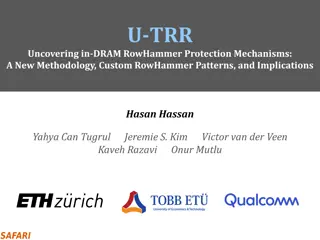
Experimental Analysis of RowHammer Vulnerability in Modern DRAM Chips
Explore the vulnerability of modern DRAM chips to the RowHammer issue through experimental analysis. The study investigates how newer technology nodes are more susceptible, the impact on system performance, and the viability of existing mitigation mechanisms.
Download Presentation

Please find below an Image/Link to download the presentation.
The content on the website is provided AS IS for your information and personal use only. It may not be sold, licensed, or shared on other websites without obtaining consent from the author. If you encounter any issues during the download, it is possible that the publisher has removed the file from their server.
You are allowed to download the files provided on this website for personal or commercial use, subject to the condition that they are used lawfully. All files are the property of their respective owners.
The content on the website is provided AS IS for your information and personal use only. It may not be sold, licensed, or shared on other websites without obtaining consent from the author.
E N D
Presentation Transcript
Revisiting RowHammer An Experimental Analysis of Modern Devices and Mitigation Techniques Jeremie S. Kim Minesh Patel A. Giray Yag l kc Roknoddin Azizi Lois Orosa Onur Mutlu Hasan Hassan
The RowHammer Vulnerability DRAM Chip Victim Row Row 0 Row 0 Row 1 Row 1 Row 1 Victim Row open closed open open closed Row 2 Row 2 Row 2 Row 2 Row 2 Row 2 Aggressor Row Row 3 Row 3 Row 3 Victim Row Row 4 Row 4 Victim Row Repeatedly opening (activating) and closing (precharging) a DRAM row causes RowHammer bit flips in nearby cells 2/6
Motivation and Goal Denser DRAM chips are more vulnerable to RowHammer Three prior works [Kim+, ISCA 14], [Park+, MR 16], [Park+, MR 16], over the last six years provide RowHammer characterization data on real DRAM However, there is no comprehensive experimental study that demonstrates how vulnerability scales across DRAM types and technology node generations Unclear whether current mitigation mechanisms will remain viable for future DRAM chips that are likely to be more vulnerable to RowHammer Goal: 1. Experimentally demonstrate how vulnerable modern DRAM chips are to RowHammer and study how this vulnerability will scale going forward 2. Study viability of existing mitigation mechanisms on more vulnerable chips 3/6
Experimental Characterization We examine 1580 total DRAM chips from 300 DRAM modules Three major DRAM manufacturers {A, B, C} Three DRAM types or standards {DDR3, DDR4, LPDDR4} Two technology nodes per DRAM type {old/new, 1x/1y} Key Takeaways 1. Chips of newer DRAM technology nodes are more vulnerable to RowHammer i.e., 69.2k to 22.4k in DDR3, 17.5k to 10k in DDR4, and 16.8k to 4.8k in LPDDR4 chips 2. There are chips today whose weakest cells fail after only 4800 hammers (i.e., 4800 accesses to two rows each) 3. Chips of newer DRAM technology nodes can exhibit RowHammer bit flips 1) in more rows and 2) farther away from the victim row. 4/6
}Mfr. A DDR3-old DDR3-new DDR4-old DDR4-new LPDDR4-1x LPDDR4-1y } DDR3-old DDR3-new DDR4-old DDR4-new Mfr. B LPDDR4-1x } DDR3-old DDR3-new DDR4-old Mfr. C DDR4-new LPDDR4-1y 10-3 of RowHammer mitigation (%) DRAM bandwidth overhead a) Mitigation Mechanism Evaluation 10-1 We evaluate system performance impact on chips of varying degrees of vulnerability for five state-of-the-art mitigation mechanisms: Increased Refresh Rate [Kim+, ISCA 14], PARA [Kim+, ISCA 14], ProHIT [Son+, DAC 17], MRLoc [You+, DAC 19], TWiCe [Lee+, ISCA 19] one ideal refresh-based mitigation mechanism: Ideal 10-2 Ideal 100 TWiCe-ideal LPDDR4-1x LPDDR4-1y 101 DDR3-new DDR4-new DDR3-old DDR4-old 102 PARA 103 105 104 103 102 Ideal Ideal ProHIT 100 90 System Performance (%) MRLoc TWiCe 80 70 Vulnerability Today Normalized TWiCe-ideal TWiCe-ideal 60 50 40 30 LPDDR4-1x LPDDR4-1y PARA DDR3-new DDR4-new DDR3-old DDR4-old Increased Refresh PARA 20 10 b) Less Vulnerable 0 105 104 More Vulnerable 103 102 HCfirst DRAM s Vulnerability to RowHammer Available mechanisms mitigate RowHammer in worst chips today with reasonable system performance (92%, 100%, 100%) We need better solutions for future chips that are likely more vulnerable
Revisiting RowHammer An Experimental Analysis of Modern Devices and Mitigation Techniques Jeremie S. Kim Minesh Patel A. Giray Yag l kc Roknoddin Azizi Lois Orosa Onur Mutlu Hasan Hassan





















